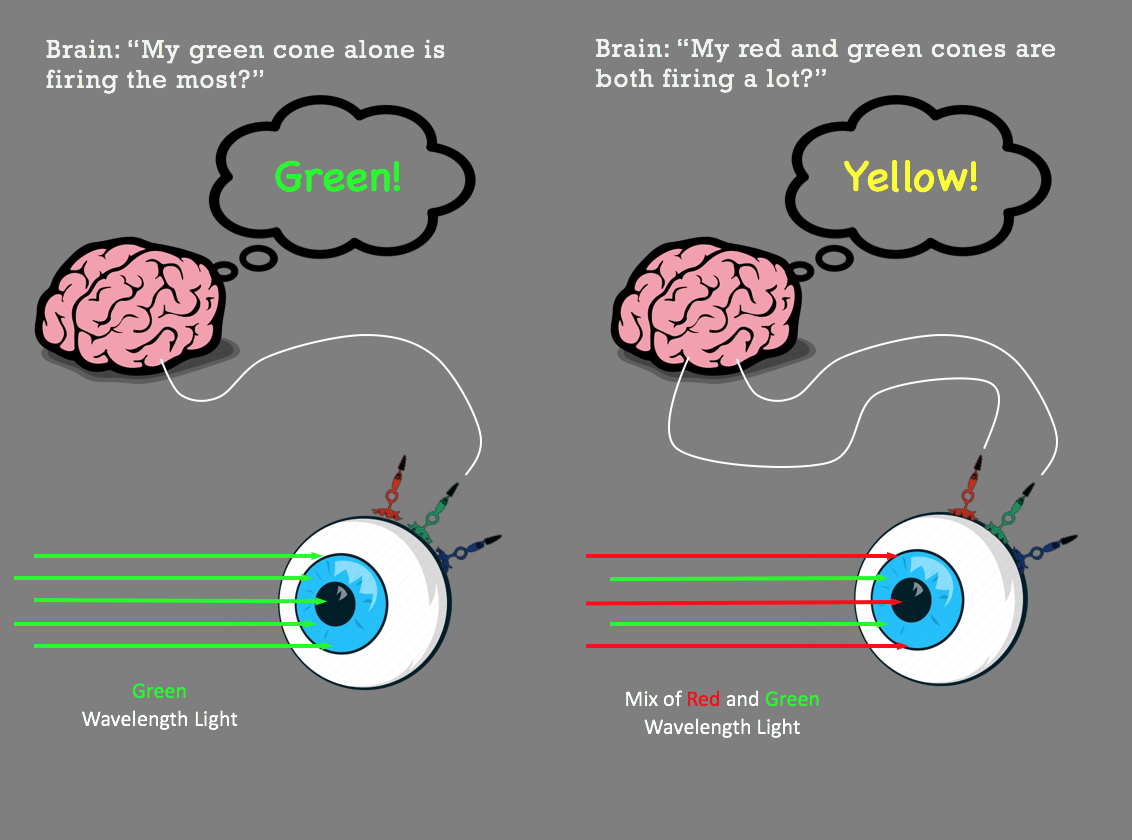A recurring theme on this blog are the subjects of categorization and semantics. And a particularly fascinating oddity shows up when we explore these concepts as applied to the world of color.
For within the world of color, it is sometimes said that the color pink is not real. And the reason why is, whether "real" or not, truly weird and mind-boggling. Because how pink comes about as an experience in the human mind is unique among the main primary and secondary colors.
Why is pink unique? We first get a hint of this by noting that pink is not present in rainbows. The main colors of the rainbow are red, orange, yellow, green, blue, indigo, violet (often abbreviated as ROYGBIV). They correspond to how colors exist in nature. Color is made up of
different kinds of light. Each color represents a certain wavelength of light, and those colors exist along a spectrum.
Each color in the spectrum has its own wavelength associated with it. Seems like that might explain everything all neat and tidy. But then we realize ... where's pink? If you're trying to find it on the spectrum, you won't be able to. It's not there. There is no single wavelength of light associated with pink. The color pink, in this sense, truly does not exist.
So, where the heck does pink come from and what even is it?
The answer lies in the fact that humans don't "see" each wavelength individually. We detect light when it enters our eyes, and within our eyes are receptors called cones. There are, for most humans, three types of cones and each is tuned to specific wavelength ranges. Each cone has a spot on the wavelength spectrum spot where it alone activates brightly while the other two cones don’t, and these correspond with the colors red, green, and blue. Red light activates the red cone. Green light activates the green cone. And our brain produces the experience of seeing red, green, and blue.
Note: The above paragraph is somewhat oversimplified for clarity and brevity compared to rather more complex underlying biology
What happens when a wavelength color without its own associated cone enters the eye? It "activates" multiple cones simultaneously, and our brain creates a new color experience. Yellow is the main color between red and green. Yellow wavelength light with activate both red and green cones strongly, and this produced the experience of yellow.
The tricky addition to the puzzle comes when more than one wavelength of light enters the eye simultaneously. If a source of green light and a source of red light are both shined into the eye simultaneously, what happens? Well, just like yellow light alone, biologically the green and red cones both become activated, and so our mind also perceives this experience as yellow.
Yellow light = red and green cones firing = experience of yellow color
Simultaneous red + green light mix = red and green cones firing = experience of yellow color
As a side note, this is how digital screen displays produce color. Each display is in fact a set of red, blue, and green light emitters placed next to each to form one pixel. Producing yellow means having the desired yellow pixels shine red and green light at your eye.
We still haven't explained pink. But here's how we'll get there.
We just mentioned that mixing red and green makes yellow. Yellow, as a wavelength, is roughly halfway between the red and green wavelengths. Another important color, teal, is what is perceived when we mix blue and green. Some cultures consider teal as it's own distinct color rather than simply being a shade of blue, and the color theory here lends some credence to that notion.
The remaining cone combination is red and blue. Looking at our light wavelength spectrum, what's halfway between red and blue? Green. So what does mixing blue and red light in our eyes produce? You guessed it, it makes pink!
Because we have a green receptor in our eye, our eye knows that green isn't present when there's only blue and red light. So, our psyche decided to create a "new" and different color instead and that's the color we experience as pink.
Semantically, we can now understand that the term pink is being used to describe all three of....
1) The experience of color within the human mind
2) The combinations of light wavelengths that, upon hitting a human eye, can trigger the human experience of pink
3) The collection of objects that, when struck with white light, will reflect back out the wavelength combinations explained in definition 2
What 1, 2 and 3 are revealing are three different subdivisions of "reality". There is the world of the human mind. There is the world of energy (heat and light). And there is the world of material objects. Each have their own "realness" to them, but each of these worlds are such different sorts of things.
The color pink is an excellent window into exploring how complex it can be to categorize each of those worlds and how different each world is.
A further interesting point is that definitions 2 and 3 are, in part, dependent and conditioned on their relationship with being a human experience. Pink objects matter as a category primarily because it's humans who see pink as its own color, so that grouping of certain objects as pink is meaningful to us. It shows us that scientific grouping and categorization can be biased toward what is being interacted. Ideally we're in theory heading toward catalogue every thing that matters to every other thing, but it's interesting to think on what biases may be present in this regard. Humans, quite naturally, find use in and will tend to build tools, including scientific tools, built to accommodate human perspectives.








No comments:
Post a Comment